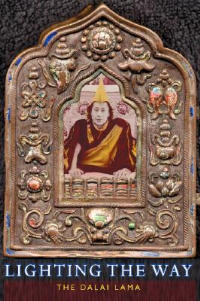 Lighting the Way
Lighting the Way

This concise and extremely accessible presentation shows how to apply Buddhist principles in our lives.
Lighting the Way contains 3 fundamental Buddhist teachings given by the Dalai Lama to Western students. "Principles of Buddhism" provides the framework for understanding the Buddha's teaching on the Four Noble Truths, upon which all of his other teachings are based. "Teachings on Eight Verses on Mind Training "comments on a classic text within the genre of Tibetan spiritual writing known as lojong (literally "mind training".) His Holiness often refers to this short work as one of his main sources of inspiration for the practice of compassion. Finally, the Dalai Lama's commentary on Atisha's Lamp for the Path to Enlightenment discusses in a lucid and inspiring manner one of the most important texts for serious practitioners of Buddhism.
The Dalai Lama, leader of the Tibetan people and Nobel Peace Laureate, is a remarkable Buddhist teacher and scholar, versed in the teachings of all the schools of Tibetan Buddhism. He has also become a global spiritual leader, whose commitment to peace and non-violence has been widely recognized, and whose message of universal individual responsibility has won world admiration and acclaim.
|
|
Foreword
This small book of teachings by His Holiness the Dalai Lama is a perfect introduction to traditional Buddhist thought and practice as understood and taught in the Tibetan tradition. Starting with the very foundation of Buddhism, the Four Noble Truths, His Holiness provides the framework and underpinnings necessary to understand the Buddha’s basic teachings on working with suffering and dissatisfaction and cultivating happiness and peace, within which the entirety of Buddhism can be taught.
Following this presentation of the Four Noble Truths, His Holiness provides extremely useful and pragmatic commentaries on two of Buddhism’s most popular and important short texts: The Eight Verses on Mind Training and Atisha’s Lamp for the Path to Enlightenment. The language and presentation in these commentaries is clear and succinct, yet extremely accessible and practical, teaching us how to apply basic Buddhist principles in our lives.
The Eight Verses on Mind Training is a classic text from the genre of Tibetan spiritual teachings called lojong or “mind training.” His Holiness often refers to this short work as one of his main sources of inspiration for the practice of compassion. Regarding these verses, the Dalai Lama has said, “I recite these verses every day and, when I meet with difficult circumstances, reflect on their meaning. It helps me.”
This practice of “mind training” consists of removing negative mental states and cultivating constructive ones. These negative states have as their basis excessive self-concern and a basic misunderstanding of the way things exist, such that we overvalue and undervalue the people and things with which we come into contact. We superimpose excessive goodness and badness upon our experiences, which then acts as a catalyst for the development of our afflictive emotions.
To overcome this excessive self-concern we need to develop heart-felt concern for others, love and compassion, the highest expression of which is the altruistic intention to become enlightened for the benefit of all beings, as well as a proper understanding of the nature of reality. We need to make this our real inner spiritual practice, and for this it always helps to contemplate and meditate upon the texts which teach about the good heart, altruism, and correct view. Such a text is the Eight Stanzas for Training the Mind written by the Kadampa Geshe Langri Thangpa.
Finally, the Dalai Lama provides a short lucid commentary on Atisha’s Lamp for the Path to Enlightenment. This text, which became the source of a genre of teachings called lamrim (stages of the path), was written for the Tibetan people by the famed eleventh-century Indian Buddhist scholar and saint Atisha and is important because, although short, it sets forth an overview of the entire Buddhist path.
Thus, the Dalai Lama explains in this book the three most fundamental topics to be found in Buddhist spiritual teachings--the Four Noble Truths, Mind Training, and Stages of the Path--in an accessible style aimed at Westerners interested in learning about authentic traditional Buddhist practice. The book also benefits from the wonderful translation by Geshe Thupten Jinpa. Therefore, this is an excellent introduction to traditional Tibetan Buddhist thought and practice. |